In the late 1980s Mitch Eckert and I spent the better part of 4 years attempting to wrap our minds around the ideas of Roland Barthes, Michel Foucault, Susan Sontag, Walter Benjamin, and a number of other heady thinkers while studying at the John Herron School of Art in Indianapolis, Indiana. We have both been fortunate in that we each were able to locate work directly related to our life-long passion: making, discussing, and thinking about images. While Eckert was in town for the Filter Photo Festival this September, we caught up to reflect upon our time spent trying to define ourselves in our youth, his ongoing experimental efforts in photography, his environmental concerns, and what he values most in his artistic and teaching practice.

Mitch Eckert, Eggs, 44×56 inches, dye sublimation on white aluminum, 2015
Lets begin with a little history. Having studied together at the John Herron School of Art In Indianapolis, Indiana, we have known each other for almost 30 years. I am wondering if you can identify any early experiences or people that you see informing your ongoing aesthetic investigations?
I tend to work on three different projects simultaneously. First it reduces the possibility of wearing out an idea before it is fully developed. In short it reduces boredom. However, I have found that working on several different concepts at the same time also allows for a more symbiotic relationship to develop between process and concept. In our undergraduate days we studied with several different teachers, John Pickle, Dornith Doherty and Linda Adele Goodine. They all had an influence on my current aesthetic investigations for various different reasons. It was the 1980’s, the hay day of postmodernism so they each approached theory from different perspectives. John provided queer theory as well as film theory. Dornith provided a great deal of critical and feminist theory as well as presenting the history of photography in a contextual way. Adele stands out because she was very experimental in her approach to teaching. She would perform exercises in the darkroom one-on-one with me that taught me how to visualize color in a new way. Both Dornith and Adele heavily influenced my color work. When I use bold primary colors that was Adele’s influence. When I work with a softer palate in works such as my explorations in natural history museums it has Dornith’s influence. However, they all taught me to think and see things in different ways. I wasn’t a straight photographer, nor did I work on street photography or portraiture. I loved working with multiple exposures, which, I believe was influenced by my interest in surrealism at the time. I also focused on collage that ended up what I would show for B.F.A. exhibition along with some of my sculpture. Gary Freeman was my sculpture mentor. He perhaps had an influence on how I work. The fact that I explore several different concepts and processes simultaneously was largely due to his influence. In general, I found coming from a feminist program with several very different and strong personalities probably had the biggest impact on my current practice. I’m able to look at things through a variety of different lenses thanks to the wonderful mentors.
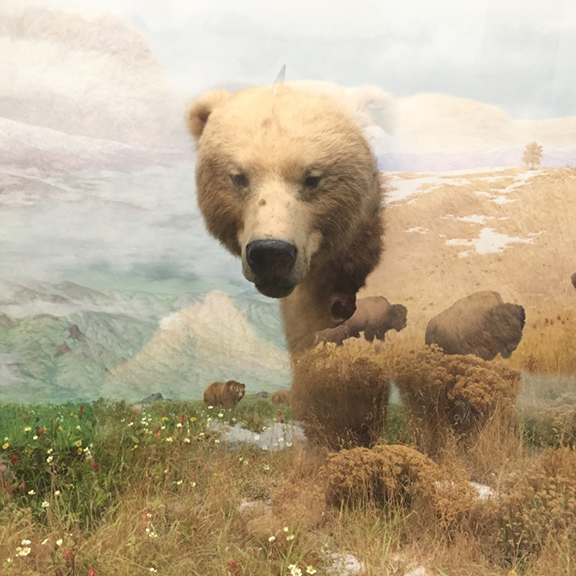
Mitch Eckert, Polar Bear and Buffalo, 16×16 inches, archival pigment print, 2016
As a professor I have been fortunate to bring in many visiting artists to the University of Louisville. I’ve spent time with Bill Owens, Duane Michals, Rosamond Purcell, Adam Fuss and Jessica Ferguson just to name a few. Of course I show them my projects to receive feedback and hear what they have to say about my work. I listen and nearly anyone I speak to I gain some new insights that I hadn’t quite considered before. The history of art and the history of photography have always had an impact on my aesthetic investigations. Knowing art history is a wonderful thing. For example, in my current exploration with photograms, I find myself looking at Anna Atkins and Wm. H. Fox Talbot as well as Moholy-Nagy, Man Ray and contemporary artists such as Adam Fuss and Christian Marclay. Knowing the history of your craft is exceptionally important! I am still a student, still researching, still learning and still being inspired by art history and the everyday. These are the skills I picked up at Herron with our fine instructors. To look. To see. To transform.
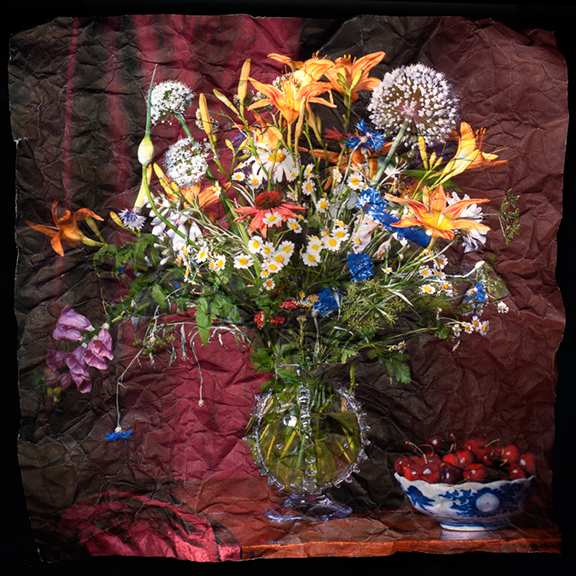
Mitch Eckert, Still Life with June Bouquet no.2, 30×30 inches, archival pigment print, 2008-2016
In looking at your work, I see that you have applied various approaches that address differing conceptual and formal strategies. Can you discuss how you negotiate and identify specific content and decide upon whether to work in a ‘straight’ photographic format or create an environment to be photographed?
I am a process-oriented artist. I find that I learn from experimentation. For me photography isn’t a ‘one size fits all’ mentality. There are so many different ways to approach a subject or concept. When a pinhole camera is going to best represent an idea I’ll use that. When a specific historic process such as Kallitype or cyanotype will better serve a concept I’ll use those processes and techniques. I had a fifteen-year love affair with still life and spent the majority of my time in Louisville and at Marian University where I taught prior after my graduate studies focusing on the nature of the object. After graduate school I found the need to arrange assemblages and photograph them with medium and large format cameras. I was heavily influenced by the work of Joseph Cornell at that time. My exploration with objects through his lens allowed me to develop the use of objects as symbols and as metaphors for memory. When flatbed scanners came on the market I was one of the first to use it as a camera to explore its lighting and ability to capture fine detail. This was a six-year exploration where I didn’t pick up a camera very often to create the body of work I have titled, Theatrical Still Life in which there is a tremendous amount of narrative happening within the scene. This narrative, by the way, was likely influenced by the work of Linda Adele Goodine. I admire how she creates a story, a narrative all within a single image. I began a still life project in which I wanted to replicate the work of the Dutch masters and so for a couple years I made hundreds of photographs with floral arrangements made from my wife Dr. Cristina Carbone with materials from our garden. I learned so much from the process of arranging something to be photographed combined with the art of lighting and working with digital and analogue cameras to capture the subject. I mentioned earlier that I was a product of postmodernism having gone to college in the 80’s. That had a profound effect on my psyche. When you and I were in school we were deconstructing images and thoughts. We wouldn’t make ‘pretty’ pictures. We didn’t work with nudes for the sake of exploring the body as an aesthetic object. We had to make work about something not of something! Well, with this still life project I figured I had earned my stripes and I wanted to make beautiful work. Work about the beauty of life and of our own mortality. I found the work to be very beautiful almost commercial and I struggled with this for months because of being a product of postmodernism. I felt guilty and afraid of making beautiful work. From this frustration I crumpled up hundreds of photographs and threw them in the wastebasket. Prior to putting them into the recycle bin I took one out. Time had passed, a week or two, but when I un-crumpled one there was a moment of epiphany! It had everything a Dutch still life painting had. It had texture and life and it was decayed, destroyed and it was beautiful and meaningful! I scanned it with my flatbed scanner and made a big print of it and fell in love with the scanner yet again! In my other still life explorations I would look at the work of the Italian painter Giorgio Morandi and make straight color photographs of white objects against neutral backgrounds as a formal exploration of light, color and form. They were beautiful and because I was dealing with very phallic objects and fruits there was content! So I embraced beauty for several years. Eventually, I took to the formal gardens of England and Italy and it was as though I was wondering through a very large still life. I began making formal explorations in black and white mainly because I hadn’t worked in monochrome for a long time and needed to prove to myself that I was capable of being a good black and white printer. The natural history museum work I am doing now is another exploration of process. I am working with in camera multiple exposures because a day in the museum becomes a blur the moment one leaves. The multiple exposures of the dioramas references that experience while simultaneously referencing migration and zoos and the fact that many species couldn’t possibly exist in the same climate, hemisphere or room together.
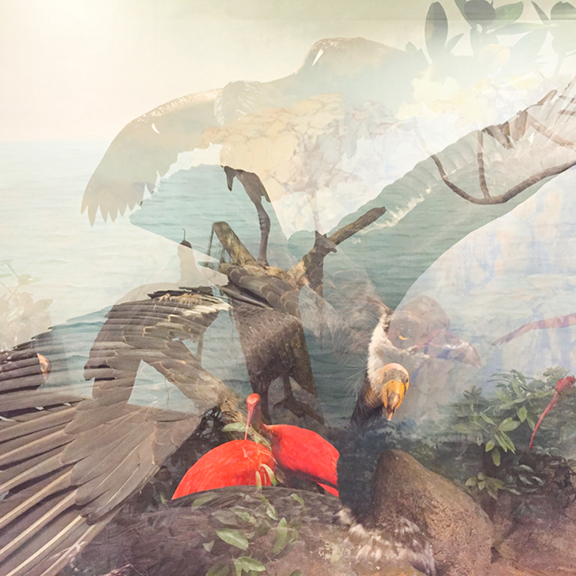
Mitch Eckert, Swooping, 16×16 inches, archival pigment print, 2016
The point is I am making work that explores the beauty of the everyday: a garden, a museum an arrangement of flowers, plastic containers etc. With processes that enrich the aesthetic and conceptual needs that I have a desire to fulfill. The lesson is that experimentation with process needs to be fully explored in order to better understand the subject.
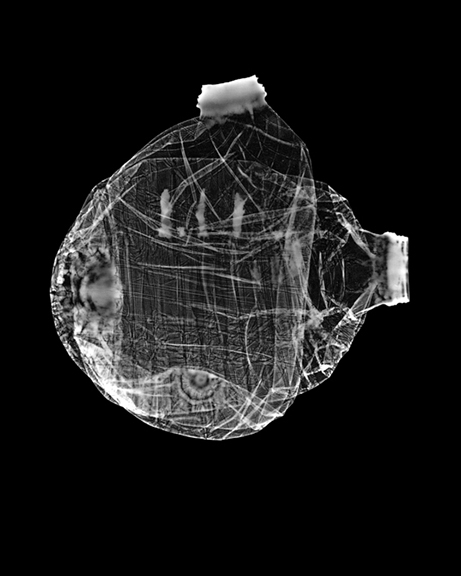
Mitch Eckert, Water Bottles, 30×40 inches, dye sublimation on white aluminum, 2016
In a number of your bodies of work I see recurring themes (constructed or found) focused upon our natural environment. Are there any specific concerns or questions that you see regularly surfacing in your investigations?
Some of the earlier still life’s are really focusing on celebrating the everyday. The history of still life demands that we embrace the everyday and enjoy the moment, because we are only here for a short time. With my landscape works I am looking at the built environment from a formal perspective while still embracing the beauty that nature provides us and that someone has taken their time and effort in trying to shape nature for us to experience. I have never been an artist who has a socially engaged practice to make work that will bring to light current issues that surrounds us. I am interested in making work that engages my curiosities and me.
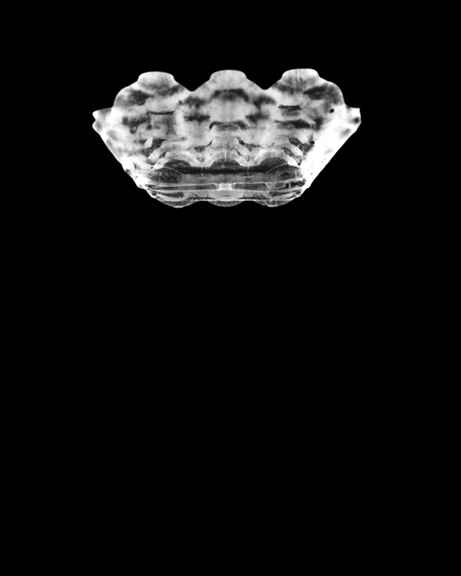
Mitch Eckert, Apricots, 30×40 inches, dye sublimation on white aluminum, 2016
I am fascinated with the recent series of works, Containers. These ghostly images are of different types of containers (often disposable). What piqued your interest to initiate these studies? What do you hope to convey in this series?
The series really began when I was shopping at Costco, a big box store, and I came across some apples in vacuum formed containers that perfectly fit the produce. It really is an exploration in my weekly accumulation of recyclable containers and my contributions to pollution. The containers are meant to be invisible. As a consumer, one picks up the container to see if they are purchasing ripe and undamaged produce. We seldom think of the container. We don’t think about their architectural beauty and the fact that they are a permanent part of our landscape. Plastic can never truly be recycled. They can be down cycled. Eventually, after the containers leave our recycle bins, they will be repurposed into grocery bags or perhaps become the filling in a winter jacket, but then after that life they will make their way into our landfills, oceans and alleyways, but they will always be a permanent part of the land. I really am struggling conceptually with this project. It seems unavoidable, the fact that these containers are how things come to us in the store. They are meant to be invisible, yet the amount of oil that it takes to run a factory that makes these things is probably enough to fuel a small city. This is the first project I have undertaken that I really can’t decide to be a socially environmentally engage artist or make the work stand out because of their marvelous forms and structures. The images begin as photograms of specimens of containers ranging from plastic water bottles and egg cartons to more abstract forms such as apricot and apple containers all designed to ensure our consumables are protected. After the photograms are made of the specimens they are scanned into the computer and printed very large, to a scale of roughly 4 x 6 feet. They are printed through dye sublimation directly onto large aluminum panels. The surface quality of the material is quite seductive and at that scale you could probably put a small person inside the container if it were 3-dimensional. They are architecturally beautiful forms. Some are very biomorphic while others are tectonic. Perhaps it is an exploration of beauty that offers a sense of wonder while informing an audience of my consumption, our consumption as a society.
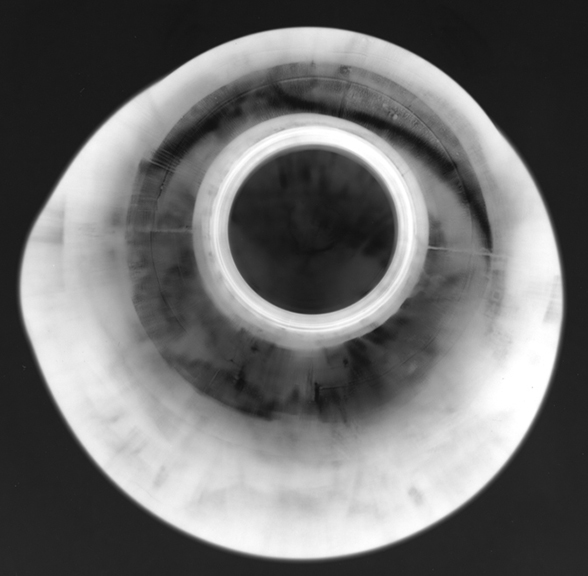
Mitch Eckert, Water, 30×30 inches, dye sublimation on white aluminum, 2016
What do you value most in your aesthetic practice?
This is a difficult if not tricky question to answer. One thing I value is time. Time is difficult to manage as an artist with a family and a full time teaching job. It takes time to sit on a project and to live with the work. I have to allow time for that to happen. Over time if a particular few pieces no longer engage me then I don’t want to exhibit the work. However, it is important to know when it is time to get the work out into the world, because, surely I am not the only one who makes work about the things I do. I don’t necessarily want to be a part of a trend with the work. I want to be ahead of the game, but how do you know when that time has come? Time is truly of the essence of life and my aesthetic practice. I need time to mull things over, to learn a new dialogue in which to discuss the work. Beyond that I need time to research processes that will bring a project to fruition. Then there is time that is necessary to complete a body of work. It is important to make time for play and creativity. The time necessary to find a place to show the work, to take the time to go to portfolio reviews to make certain there is an audience for the work. It takes time to know if something should be in black and white or in color. Time is necessary to figure out if something should be 2D, 3D, 4D or virtual. Time! Is it aesthetic? Maybe not, but it is the thing I value most in my artistic practice.

Mitch Eckert, Bottles, 40×40 inches, dye sublimation on white aluminum, 2016
In addition, you teach at the Hite Art Institute in the Department of Fine Arts at the University of Louisville. Are there any recurring items that you share with your students to assist them in assembling a foundation in their art or photography practice?
I love teaching! Things have changed since you and I were in school. We were not a generation of students that were spoon-fed our education. The advice I think we had in our courses together was to go out there and pave the way to your success. That meant we had to go out and talk to people to find out how to do this or get feedback on that. There was a lot of knocking on doors, facing rejection, celebrating the success, and trying to pay attention to trends while being individuals. Now in my late 40’s I have learned some things that I can share with students. These are things I should have learned twenty years ago, but my ambition wasn’t to be a practicing artist. My passion was to teach, challenge and inspire students of all ages. I won’t say that a generation of millenial or X’rs are apathetic and need to be spoon fed, but there have been trends recently of this type of apathy. What I want to do is to instill students with a sense of curiosity to think critically and to embrace whom they are as artists and individuals in this world and that we all have something to offer. And that we all can leave our marks on the world! Most recently I have been trying to get my work into exhibitions around the country. I am participating in portfolio reviews, sending out emails and cover letters. I am reaching out to curators and gallery directors. I have never done this before. But now I need some exhibitions and some sales! I’ll be stepping up for full professor in the near future and I can’t sit idly by waiting for things to happen. So now I am reaching out to my mentors for advice! I am sharing my experiences with my students. I don’t have any secrets! We are all in this together. I have no desire to be a New York art star. That would be great and if it were my goal I am sure I would make the appropriate connections, but I love to inspire and to teach! Joseph Campbell once stated, “Follow your bliss.” Essentially that is what I preach and what I do. I’m a mid-career artist and now I am putting myself out into the art world. Now I have 10 different bodies of work and surely someone is going to respond to one of those series. What I share with my students are the things I learn on a daily basis. When I bring in visiting artists, curators, gallery and art directors they have to engage them. They have to ask the questions! They have to participate in their own education! All of my life experiences go into my classroom whether personal or practical. Like Walt Whitman once said in his epic poem, Leaves of Grass, for every atom belonging to you as well belongs to me. We are truly one, and I believe in open mentorship!

Mitch Eckert, Kiwi, 40×40 inches, dye sublimation on white aluminum, 2015
What’s the plan for the remainder of 2016? Do you have any upcoming exhibitions or projects that are currently in process that you hope to realize by the end of the year?
We are three months away from 2017 and I have been in eleven juried exhibitions for the year! I have work included in the International Photography Annual published by Manifest Press in Cincinnati Ohio. I pride myself on exhibiting new work that others haven’t seen. Manifest Gallery in Cincinnati has showcased works from 3 different bodies of new work I have not exhibited. I have had my landscape works shown at the Annapolis Maritime Museum, The Center for Fine Art Photography in Fort Collins CO., the Midwest Center for Photography in Wichita, KS and the latest photogram’s from my, Containers series has been featured in Context at Filter Photo Space in Chicago and A Point of View: Contemporary Photography at SITE: Brooklyn in New York. It has been a busy year! I’m currently polishing my art and natural history museum works as well as the plastic containers work. I am currently trying to find exhibitions of this most recent work! I have several positive prospects with Klompching Gallery in Brooklyn, The Griffin Museum near Boston and the International Center for Photography in Chicago. It has been a crazy busy year for life, art making and teaching!

Mitch Eckert, Blueberries, 44×56 inches, dye sublimation on white aluminum, 2016
For additional information on the work of Mitch Eckert, please visit:
Mitch Eckert – http://www.mitcheckert.com/
Manifest Gallery – http://www.manifestgallery.org/inpha/inpha1/20.html
Art Slant – http://www.artslant.com/global/artists/show/407738-mitch-eckert
Artist interview by Chester Alamo-Costello


